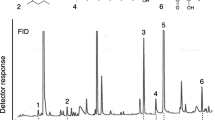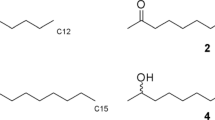Abstract
In laboratory trail-following bioassays of Argentine ant workers,Iridomyrmex humilis (Mayr), the geometric isomer, (E)-9-hexadecenal, of the trail pheromone component (Z)-9-hexadecenal elicited insignificant trail following as did the potentially more stable formate analogs, (Z)-7-tetradecenyl formate, (E)-7-tetradecenyl formate, and tetradecyl formate. Further, in direct choice tests, workers showed no preference for gaster extract trails (0.002 ant equiv/cm) over trails of (Z)-9-hexadecenal (0.2 ng/cm). Moreover, a 10-fold increase in synthetic trail concentration to 2.0 ng/cm caused (Z)-9-hexadecenal trails to be significantly preferred over gaster extract trails by trail-following ants.
Similar content being viewed by others
References
Benthuysen, J.L., andBlum, M.S. 1974. Quantitative sensitivity of the antPogonomyrmex barbatus to the enantiomers of its alarm pheromone.J. Ga. Entomol. Soc. 9(4):235–238.
Blum, M.S., Doolittle, R.E., andBeroza, M. 1971. Alarm pheromones: utilization in evaluation of olfactory theories.J. Insect Physiol. 17:2351–2361.
Caputo, J.F., Caputo, R.E., andBrand, J.M. 1979. Significance of the pyrrolic nitrogen atom in receptor recognition ofAtta texana (Buckley) (Hymenoptera: Formicidae) trail pheromone and parapheromones.J. Chem. Ecol. 5(2):273–278.
Caro, J.H., Glotfelty, D.E., andFreeman, H.P. 1980. (Z)-9-Tetradecen-1-ol formate distribution and dissipation in the air within a corn crop aftr emission from a controlled-release formation.J. Chem. Ecol. 6(1):229–239.
Cavill, G.W.K., Robertson, P.L., andDavies, N.W. 1979. An Argentine ant aggregation factor.Experientia 35:989–990.
Cavill, G.W.K., Davies, N.W., andMcDonald, F.J. 1980. Characterization of aggregation factors and associated compounds from the Argentine ant,Iridomyrmex humilis.J. Chem. Ecol. 6(2):371–384.
Cross, J.H., Mitchell, E.R., Tumlinson, J.H., andBurnett, D.E. 1980. Selection of a polyethylene tubing formulation of (Z)-9-tetradecen-1-ol formate and its use in disrupting pheromone communication inHeliothis zea (Boddie).J. Chem. Ecol. 6(4):771–779.
Mitchell, E.R., Jacobson, M., andBaumhover, A.H. 1975.Heliothis spp.: Disruption of pheromonal communication with (Z)-9-tetradecen-1-ol formate.Environ. Entomol. 4:577–579.
Mitchell, E.R., Baumhover, A.H., andJacobson, M. 1976. Reduction of mating potential of maleHeliothis spp. andSpodoptera frugiperda in field plots treated with disruptants.Environ. Entomol. 5:484–486.
Riley, R.G., Silverstein, R.M., andMoser, J.C. 1974. Isolation, identification, synthesis and biological activity of volatile compounds from the heads ofAtta ants.J. Insect Physiol. 20:1629–1637.
Sonnet, P.E., andMoser, J.C. 1972. Synthetic analogues of the trail pheromone of the leaf-cutting ant,Atta texana (Buckley).J. Agric. Food Chem. 20(6):1191–1194.
Sonnet, P.E., andMoser, J.C. 1973. Trail pheromones: Responses of the Texas leaf-cutting ant,Atta texana, to selected halo- and cyanopyrrole-2-aldehydes, ketones, and esters.Environ. Entomol. 2(5):851–854.
Van Vorhis Key, S.E., andBaker, T.C. 1981. Trail following responses of the Argentine ant,Iridomyrmex humilis (Mayr), to a synthetic trail pheromone component and analogs.J. Chem. Ecol. 8(1):3–14.
Van Vorhis Key, S.E., Gaston, L.K., andBaker, T.C. 1981. Effects of gaster extract trail concentration on the trail following behavior of the Argentine ant,Iridomyrmex humilis (Mayr).J. Insect Physiol. 27(6):363–370.
Author information
Authors and Affiliations
Rights and permissions
About this article
Cite this article
Van Vorhis Key, S.E., Baker, T.C. Specificity of laboratory trail following by the argentine ant,Iridomyrmex humilis (Mayr), to (Z)-9-hexadecenal, analogs, and gaster extract. J Chem Ecol 8, 1057–1063 (1982). https://doi.org/10.1007/BF00987886
Received:
Revised:
Issue Date:
DOI: https://doi.org/10.1007/BF00987886




